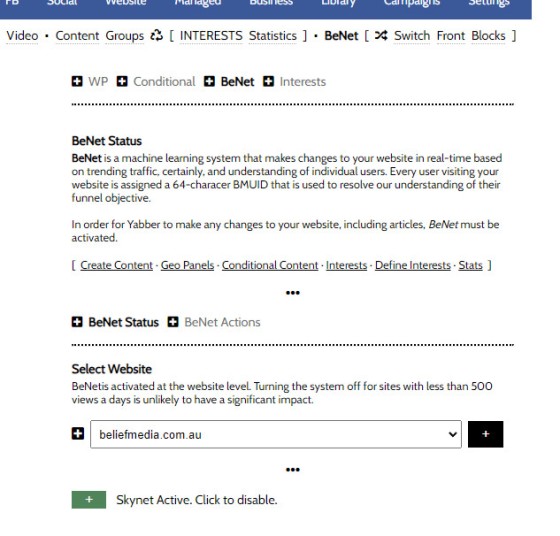Almost without question, BeNet is the single most sophisticated AI made available in the finance industry. For all intents and purposes, it has to be considered to be an extremely knowledgeable mortgage broker with an expert understanding of digital marketing, processes, systems, policies, property, finance, best practice, and your marketing efforts. BeNet is connected to Yabber's Conditional Modules and works as a process that sits on top of your website which allows it to take a holistic helicopter-view of your entire online operation.
BeNet is capable of making phone calls, authoring and sending emails, actioning entire files and communicating with clients, and doing just about everything else that a mortgage broker will do as part of their entire processing pipeline. In a sense, many would consider the capability of the system to be the future of the industry. That all said, most of the features are entirely experimental and only used with direct oversight by brokers participating in high-level campaign management. However, the marketing components of BeNet are generally available to all clients.
The primary purpose of BeNet as it applies to the majority of Yabber subscribers is to develop an extremely accurate understanding of the borrowing objective of each of your website clients. On the basis of the understanding of each individual client and that of trending consumer sentiment, it will cause your website to change shape and deliver content to users that is more closely aligned with their interest, occupation, or borrowing objective. The AI has the capacity to add its own content to your website in defined locations, change the nature and direction of funnels, and give you notice of clients that should be contacted directly based on predictive conversion patterns. It's a highly sophisticated system.
At some point in the future, the entirely of BeNet will be made available to all clients. For the moment, consider it a website tool.
We could write a book on BeNet, so the FAQ doesn't address the wide-ranging functionality. Instead, we'll look at how to activate and deactivate the system. Before you activate BeNet we expect you to have discussions with us so you understand its actions, and we'd also expect you would read any literature and watch any tutorial videos.
Locating BeNet
From the 'Website' module, select the 'Funnel' icon which will take you to the 'Conditional' Module, then select BeNet from the Conditional submenu.
Pictured: From the 'Website' module, select the 'Funnel' icon which will take you to the 'Conditional' Module, then select BeNet from the Conditional submenu.
Enable or Disable BeNet
Once on the BeNet status page, selecting your website will return the BeNet status as it applies to each of your registered websites. Enable or disable as required.
Pictured: Once on the BeNet status page, selecting your website will return the BeNet status as it applies to each of your registered websites. Enable or disable as required.
BeNet Features
At the time of writing this FAQ, BeNet is approaching 10 years in service. Once almost exclusively a machine-learning system, the feature has evolved considerably since the introduction of various Large Language Models and other AI tools. In fact, we now see improvements in days that would have otherwise taken years.
BeNet is not required for Conditional Content... but it will improve our ability to actively resolve what content should be shown for each individual website user. The function of BeNet essentially emulates the types of actions a user might make on your website with the exception that it does so in real-time and with zero delay or development time. BeNet must to be considered a real person, and you should keep this fallibility in mind if you choose to activate the system because the seriously genius but infant AI can and will make mistakes.
As a user browses your website, BeNet will do its best to resolve the objective of the user, but it does so via contextual guesses so isn't always accurate. Throughout Yabber you will often have the option of defining a 'Primary Interest', and this declaration feeds the system with a clear understanding of the purpose of the link, modal, video or whatever other asset the user is interacting with... so, on the basis of this known objective, occupation, or interest, Yabber is able to quickly determine and resolve the preferred pathway for the client.
If you're unfamiliar with the risks of BeNet, or you don't want it making temporary content changes to your website, please do not activate the system.
■ ■ ■
Conditional Content FAQs
The Conditional content module is significant. The FAQs listed below may exclude some of the basic conditional features, such as some of the Front Page conditional blocks.
Your website includes a very large number of methods to include different types of headings, including Titles and Statements (both of which serve a specific purpose), with other shortcode and Elementor tools making the addition of various 'headings' a piece of cake. While there are any number of ways to generate page titles,… [ Learn More ]
The First Email is an action that will conditionally send the first email to a user after a subscription of any type based on their form interaction. The First Email sent to a user will be determined based on the nature of their subscription - are they a subscriber, phone contact, or calendar booking? A… [ Learn More ]
The Conditional Content Blocks arguably the more effective method of rendering blocks of conditional content. The 'Blocks' module introduced similar functionality to what we're about to described, but if you're starting with Conditional Content, we'd suggest you use this module rather than Blocks simply because of the ease a single page may be assigned… [ Learn More ]
Conditional Content is one of the defining features of your website framework. Despite the fact the Conditional Content blocks are often avoided because of the perceived complexity, they seriously amplify the effectiveness of any organic or promoted funnel. We appreciate that many brokers just 'want a website', and that's find, but if and when the… [ Learn More ]
We generally advocate for brokers to position themselves in various ways by way of standalone websites that have a defined siloed audience and serve a very specific purpose. However, managing multiple websites can be problematic for a number of reasons, with duplicate content and time requirements probably topping the list. If managed correctly - and… [ Learn More ]
You want those marketing assets on the periphery to property represent your brand, but you also want them to be consistent with your trending website traffic or consumer sentiment. For example, with the introduction of a FHB or Investor incentive of some kind you will likely want your broader marketing footprint to reflect this, or… [ Learn More ]
You want those marketing assets on the periphery to property represent your brand, but you also want them to be consistent with your trending website traffic or consumer sentiment. For example, with the introduction of a FHB or Investor incentive of some kind you will likely want your broader marketing footprint to reflect this, or… [ Learn More ]
It's typical to change your social media banners of all types based on seasons, such as Christmas, Anzac Day, Easter or similar. A module in Yabber permits you to define start and stop dates for a specific banner, and that banner will automatically be applied (and later replaced with your 'default' banner). This FAQ shows… [ Learn More ]
Conditional Content is content that is delivered to a user based on resolved borrowing objective, occupation, campaign links, or interest. In the property field the Interest might be a particular type of property or a category of buyer. Supported by BeNet, the use of Conditional Content must be considered an advanced feature, although those… [ Learn More ]
Almost without question, BeNet is the single most sophisticated AI made available in the finance industry. For all intents and purposes, it has to be considered to be an extremely knowledgeable mortgage broker with an expert understanding of digital marketing, processes, systems, policies, property, finance, best practice, and your marketing efforts. BeNet is connected to… [ Learn More ]
In a previous FAQ we look at how to create and manage "Entry and Exit Intent Modals" for Your Entire Website or a Single Page. The system defined modals that will shown on your website after a defined number of seconds, or when the user indicates intent to leave the page. In this FAQ… [ Learn More ]
This FAQ will details how to use the standard Entry and Exit modals on your website. The Modal module is quite large and includes a number of options designed specifically for the finance industry, so what we're dealing with here is how to create and maintain the 'standard' entry and exit modal as it applies… [ Learn More ]
Resulting from various State-level Government incentives and fees, one of the areas that differs significantly from state-to-state is the purchase of a first home. The FHB Panel is one of the simplest conditional features of any type to use because it serves content that is resolved by State - not interest, which is the typical… [ Learn More ]
Conditional Content is content that is delivered to a user based on resolved borrowing objective, occupation, campaign links, or interest. Your website is a shape-shifting chameleon in that it delivers different content to different users in order to maintain higher levels of engagement and ultimately convert more clients. Conditional features are designed to amplify the… [ Learn More ]
Forma And Panel escalation is a component of the large Conditional Content framework that underpins your mortgage broker website and finance funnels. Basic conditional content features are introduced in an FAQ titled The Basics of Conditional Content and Interest Types, while advanced methods are addressed individually. One of the simplest conditional options to employ… [ Learn More ]








